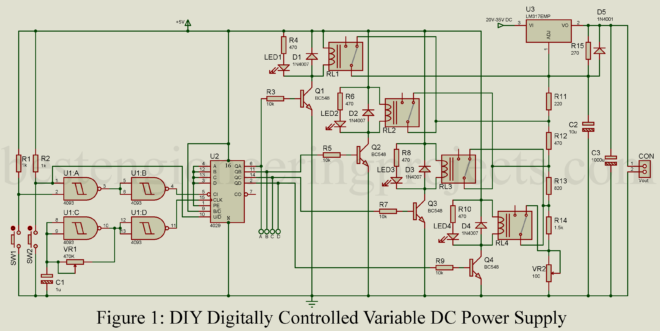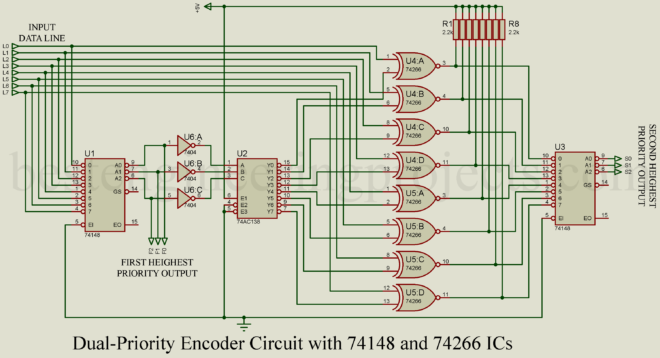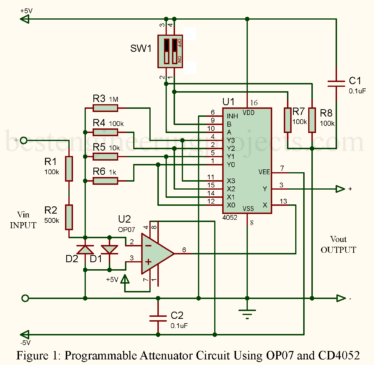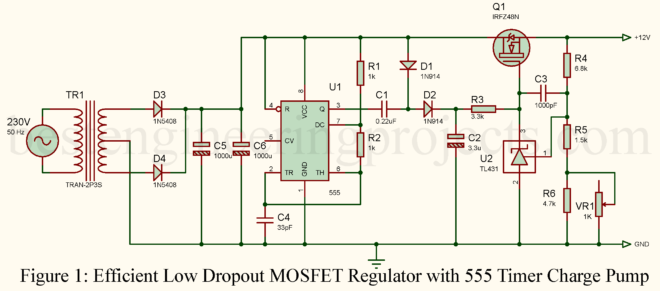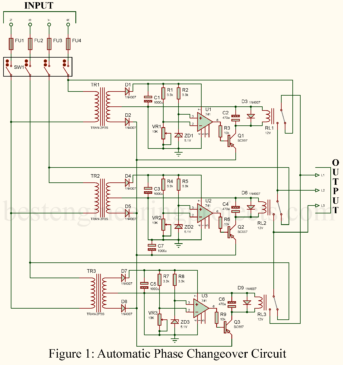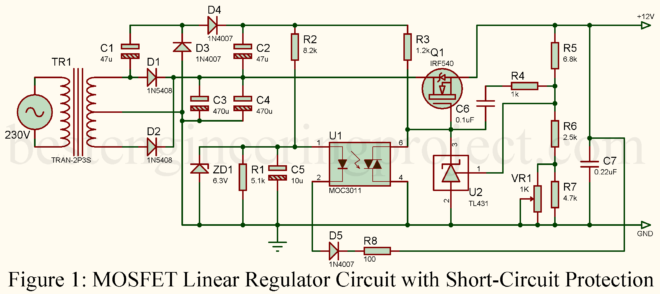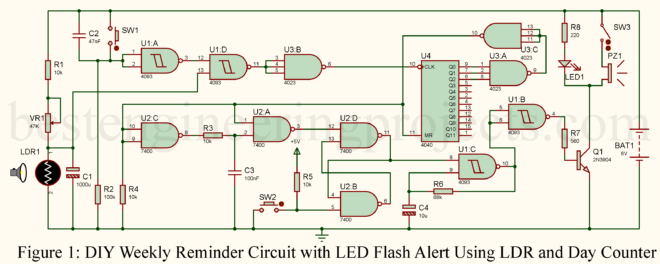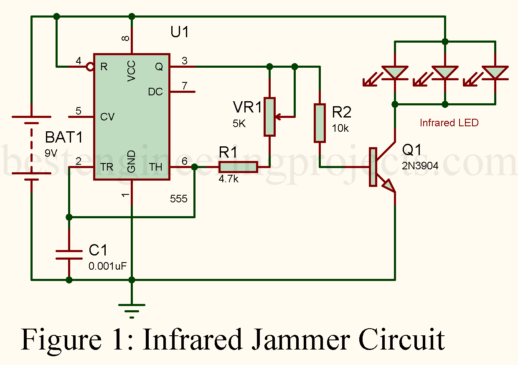Imagine that you are in the middle of an important project, and suddenly your batteries run out. That’s frustrating, right? Well, here’s the good news-you can build your very own battery charger circuitry that’s intelligent, efficient, and automatic. Using an LM317 voltage regulator and a relay, this circuit not only charges your batteries but also stops charging once they’re full. Think of it as a responsible babysitter for your batteries! This guide walks you through a simple battery charger design that can safely charge four series-connected AA cells (1.5V each).…
Read MoreDIY Variable Power Supply with Auto Shut-Off Using LM7805
Ever needed a power supply that just, well, works on your terms? Imagine this: you’re in your workshop, deep into an electronics project, and you wish your power supply could give you just the right voltage, no questions asked. And better yet, what if it turned itself off when you’re done? That’s where this DIY Variable Power Supply with Auto Shut-Off, with the trusty LM7805 at its heart, comes in. It’s your reliable “set-it-and-forget-it” friend for every hobbyist in electronics. So, what’s all this about? Think of this that way:…
Read MoreDIY Digitally Controlled Variable DC Power Supply (1.25V to 15.19V) Using LM317 and 4029 Counter
Imagine being able to control voltage like turning a volume knob, only instead of sound, you’re tuning up or down the power flowing to your electronics. Today, we’re going to create a variable DC power supply with digital controls, using a few nifty components that make this process not just adjustable, but satisfyingly precise. Building this digitally controlled variable DC power supply might sound complex, but I promise it’s like baking with a recipe—it just takes the right steps. So, let’s dive into it. Why Go Digital with Voltage Control?…
Read MoreDual-Priority Encoder Circuit with 74148 and 74266 ICs
Imagine this: you’re a traffic cop in the middle of a very busy intersection. Cars from every direction are honking, each one demanding to go first. You’ve gotta make a decision, right? Now, picture that some of these cars have more “urgency” than others—maybe an ambulance is in the mix, but there’s also a VIP car behind it. Wouldn’t it be useful to know not only who needs to go first but also who should go second? Well, in the world of digital electronics, that’s what we’re doing with this…
Read MoreProgrammable Attenuator Circuit Using OP07 and CD4052
Accuracy and control are especially in great demand in the domain of test and measurement systems in today’s digital world. For that reason, there is much room for improvement in the design of the digitally controlled programmable attenuator circuit in terms of accuracy and flexibility of signal processing. The following article guides on how to design a programmable attenuator circuit with the OP07 operational amplifier and CD4052 analog multiplexer. Combining them yields a high degree of signal attenuation in a digitally controlled manner, quite essential in instrumentation and test or…
Read MoreEfficient Low Dropout MOSFET Regulator with 555 Timer Charge Pump
Efficient power regulation with a minimum drop in voltage has become quite necessary in modern electronics, especially when one works with low-voltage DC supplies. It is in meeting such requirements that a Low Dropout MOSFET Regulator becomes handy-assuring stable output with reduced dissipation of power. The following article elaborates on the design for an Efficient Low Dropout MOSFET Regulator, employing a 555 Timer Charge Pump to develop a higher gate voltage for the MOSFET, thereby realizing ultra-low dropout performance. Why Use a Low Dropout MOSFET Regulator? In conventional linear regulators,…
Read MoreAutomatic Phase Changeover Circuit for Continuous Power Supply
The most important feature in a three-phase electrical system is that the supply of power to critical equipment must not be interrupted, especially at places where voltage fluctuations are common. The practical solution for this problem is an automatic phase changeover circuitry. It enables the equipment to smoothly switch to another phase in case one or more phases have low voltage, thereby ensuring a continuous power supply. In this article, we explain how an automatic phase changeover circuit works, what its main components are, and how you can build a…
Read MoreUltra-Low Dropout MOSFET Linear Regulator Circuit with Short-Circuit Protection
Ever tried building a stable power supply only to find it wastes a ton of power in the form of heat? That’s where this MOSFET-based ultra-low dropout linear voltage regulator comes in handy. This design keeps power losses to a minimum, making it a great choice when you need an efficient, stable 12V output. Plus, it has built-in short-circuit protection, so it’s safe to use in demanding environments. Let’s dive into the details! Why Choose a MOSFET for Ultra-Low Dropout? Traditional regulators can drop quite a bit of voltage, which…
Read MoreDigital DIY Reminder Project
Ever want a no-frills reminder for weekly tasks without all the fuss or complication? Such may be your DIY Weekly Reminder Circuit! The LED Flash Alert, along with the LDR and a day counter, may all combine into a low-power reminder to take out the trash, water the plants, or return that overdue library book. Once programmed, it blinks an LED to remind you on the same day of every week and will continue to do so until the reset button is pressed. Well, here is how the Digital DIY…
Read MoreHow to Build an Infrared Jammer Circuit
The infrared jammer circuit can be utilized for either practical means or to create a fun experiment. The general idea is that this little contraption is supposed to be powered by a high-powered infrared light that works against any gadget dependent on infrared signals, including TV remotes, auto-focus cameras, and even devices of the spy class. In this guide, you’ll learn how to build your own infrared jammer circuit to block infrared signals in a room. This tutorial is ideal for hobbyists and those interested in counter-surveillance. How Does an…
Read More

